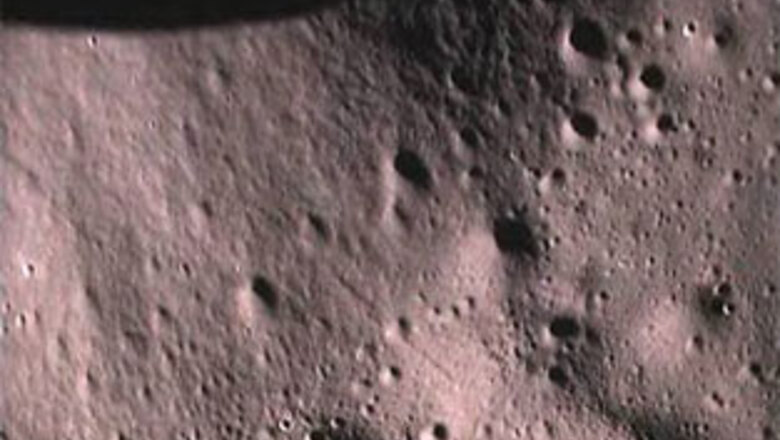
views
Bangalore: In a discovery hailed as path-breaking, India's maiden lunar mission Chandrayaan-1 has found evidence of water on the moon.
The Indian Space Research Organisation (ISRO) late on Thursday confirmed that Chandrayaan-1 has detected presence of water on the moon.
"Excellent quality data from the Moon Mineralogy Mapper (M3) instrument of the National Aeronautics and Space Administration (NASA) had clearly indicated the presence of water molecules on the lunar surface extending from lunar poles to about 60 degrees latitude," ISRO said in a statement on its website.
Earlier in the day, M3 principal investigator Carle Pieters in a paper published in Science Express, in the September 24 edition said that Chandrayaan-1 found evidence of water on the lunar surface.
M3 was one of the 11 scientific instruments onboard Chandrayaan that ISRO launched on October 22, 2008, but the moon mission had to be aborted on August 30 after Chandrayaan-1 lost radio contact with the earth.
Acknowledging that analysis of the data from M3 had led to a path-breaking finding, ISRO quoted from the paper that hydroxyl, a molecule consisting of one oxygen atom and one hydrogen atom, was also found in the lunar soil.
"The confirmation of water molecules and hydroxyl molecules on the moon's polar regions raises new questions about its origin and its effect on the mineralogy of the moon," the space agency pointed out.
The findings from M3 show a marked signature in the infrared region of 2.7-3.2 micron in the absorption spectrum, which provided a clear indication of the presence of hydroxyl and water molecules.
The analysis of the huge volume of M3 data was carried out by a joint team of scientists from the US and India.
The scientific team was led by Pieters, a planetary geologist at Brown University in Rhode Island, and Principal Scientist of Chandrayaan-1 from Physical Research Laboratory (PRL) of the Indian Department of Space, J N Goswami.
The team had concluded that there were traces of hydroxyl (OH) and water (H2O) molecules on the surface of the moon closer to the polar region.
The experts also concluded that traces of OH and H20 were in the form of a thin layer embedded in rocks and chemical compounds on the surface of the moon and the quantity were extremely small - of the order of about 700 parts per million (ppm).
"These molecules could have come from the impact of comets or radiation from the sun. But most probable source could be low energy hydrogen carried by solar wind impacting on the minerals on lunar surface. This in turn forms OH or H2O molecules by deriving the oxygen from metal oxide," the statement explained.
With these findings, the team revisited the data from NASA's Deep Impact Mission of 2005, which carried an instrument similar to M3.
The Deep Impact Probe observed the moon for a week June 2-9, 2009.
"This data, along with some laboratory tests carried out from samples brought from Apollo missions, confirmed that the signature is genuine and there is a thin layer of surface mineral which contains traces of hydroxyl and water molecules," ISRO reiterated.
The M3 observations are strengthened by results obtained from the analysis of archived data of lunar observation in 1999 by another NASA mission, Cassini, on its way to Saturn. This data set also revealed signatures of both OH and H2O absorption features on the lunar surface.
The NASA payload also found water molecules and hydroxyl at diverse areas of the sunlit region of the moon's surface, but the water signature appeared stronger at the moon's higher latitudes.
"We've made a very important step with this discovery, and now there are some very important steps to follow up on," Pieters said.
Crediting ISRO for its role in the findings, Pieters said: "If it were not for them (ISRO), we would not have been able to make this discovery."
Scientists have speculated that water molecules may migrate from non-polar regions of the moon to the poles, where they are stored as ice in ultra-frigid pockets of craters that never receive sunlight.
Though the abundances are not precisely known, about 1,000 water molecule parts per million could be in the lunar soil, the paper noted.
"Harvesting one ton of the top layer of the moon's surface will yield as much as 32 ounces of water," scientists involved in the discovery said.
Chandrayaan-1 Project Director M Annadurai said the discovery of water on the moon was one of the scientific achievements of the country's maiden lunar mission.
"The baby has done its job by finding water on the moon," Annadurai told IANS.
The scientific feat has been termed a landmark event in international space cooperation between India and other countries.
"It is one of the milestones. We have to quantify it. It was a combined team effort. Finding out presence of water or ice has been one of the mission's scientific objectives apart from terrain mapping and mineral mapping," Annadurai recalled.




















Comments
0 comment